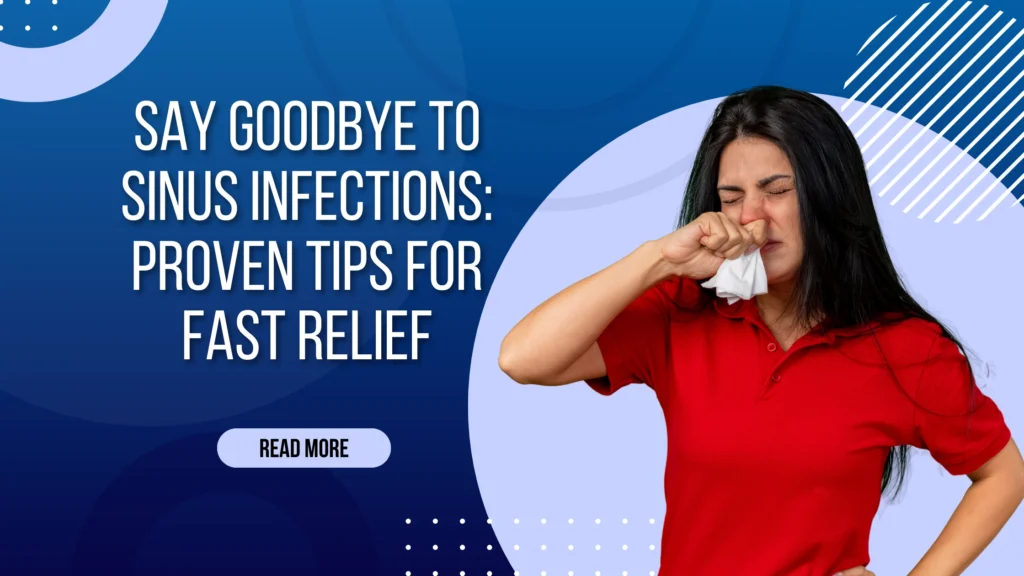Sinus infections, also called sinusitis, are a significant health issue in the United States, impacting approximately 31 million people annually. Sinusitis accounts for 16 million doctor visits each year. Individuals at higher risk include those with allergies, asthma, structural nasal or sinus blockages, or weakened immune systems.
This article reviews the introduction, etiology, classification, diagnosis, management, and conclusion. “Let’s dive deeper into this fascinating topic- Sinus infection, providing the insights you need to discover effective solutions.”
INTRODUCTION
Definition: Sinusitis refers to the inflammation of the sinuses, typically caused by a bacterial infection, though viruses and fungi (molds) can also be responsible. Individuals with weakened immune systems are more susceptible to bacterial or fungal sinus infections. Additionally, people with allergies may develop an “allergic fungal sinus infection.”
- Within the bony structure of the cheeks
- Behind the forehead and eyebrows
- On either side of the bridge of the nose
- Behind the nose, directly in front of the brain
An infection in a sinus cavity near the brain can be life-threatening if left untreated, as it may spread to the brain in rare cases.
Under normal conditions, sinuses are lined with a thin layer of mucus that traps dust, germs, and other airborne particles. Tiny hair-like projections (called cilia) sweep the mucus and trapped particles toward openings that lead to the back of the throat, where it is swallowed and sent to the stomach. This process is a normal and essential function of the body.
Sinus infections, or sinusitis, occur when the normal drainage of mucus from the sinuses is obstructed, often due to swelling caused by infections or allergies. This blockage prevents the “sweepers” (tiny, hair-like structures called cilia) from clearing mucus efficiently, leading to mucus buildup in the sinuses.
Additionally, certain anatomical or structural issues can predispose individuals to sinus infections by further obstructing drainage. The most common defects include:
- Deformity of the Nasal Septum: A deviation in the bony partition that separates the two nasal passages can impair airflow and mucus drainage.
- Nasal Polyps: These are benign growths within the nasal passages that may obstruct sinus openings and trap mucus.
- Narrowing of the Sinus Openings: This structural feature limits the ability of mucus to drain effectively, increasing the risk of infection.
Conquer asthma, one breath at a time—empower yourself with knowledge and take control of your health.
ETIOLOGY
Sinusitis, or inflammation of the sinuses, can have a variety of causes. It often occurs when something blocks the normal drainage of mucus, creating an environment conducive to infection. Here are the main causes of sinusitis:
Common Cold: Viral infections like colds can inflame the nasal passages, blocking sinus openings and leading to bacterial or fungal infections.
Allergies: Allergic reactions, such as hay fever, can cause nasal tissue swelling and increased mucus production, contributing to sinus blockage and infection.
Structural Abnormalities: Issues like a deviated nasal septum, nasal polyps, or other structural irregularities can interfere with mucus drainage and increase the risk of sinusitis.
Enlarged Adenoids: In children, enlarged adenoids can block sinus drainage pathways, leading to sinusitis.
Activities Like Diving and Swimming: These activities can introduce water into the nasal passages, potentially carrying bacteria into the sinuses.
Tooth Infections: Infections in the upper teeth can spread to nearby sinuses, especially the maxillary sinuses.
Nasal Injuries: Trauma to the nose can cause swelling or structural damage, which might block sinus drainage.
Foreign Objects in the Nose: Particularly common in children, objects lodged in the nasal passages can block drainage and lead to sinusitis.
Exposure to Secondhand Smoke: Smoke can irritate and inflame the nasal passages, increasing the risk of sinus infections.
TYPES: These classifications appear to describe types of sinus infections or sinusitis. Here’s a summary of the four types:
- Acute Sinusitis
○ Duration: Symptoms last less than 4 weeks.
○ Cause: Often due to a viral infection, though bacterial infections are possible.
○ Treatment: Typically resolves with proper care, such as rest, hydration, over-the-counter medications, or prescribed treatments.
● Subacute Sinusitis
○ Duration: Symptoms persist for 4 to 8 weeks.
○ Characteristics: Does not respond well to initial treatment.
○ Cause: This may result from a prolonged or incomplete recovery from an acute infection.
● Chronic Sinusitis
○ Duration: Symptoms last for 8 weeks or longer.
○ Characteristics: Often associated with structural issues, allergies, or recurrent infections that are inadequately treated.
○ Management: This may require more intensive interventions like nasal corticosteroids, allergy treatments, or surgery.
● Recurrent Sinusitis
○ Definition: Occurs when a person experiences 3 or more episodes of acute sinusitis within a year.
○ Characteristics: Each episode resolves but recurs frequently.
○ Causes: Can be linked to immune system deficiencies, allergies, or anatomical issues.
SYMPTOMS:
symptoms that can vary depending on age. Below is a summary of common symptoms:
Younger Children
● Runny nose: Lasts more than 7 to 10 days; discharge may be thick green or yellow but can also be clear.
● Cough: Typically worse at night, though occasional daytime coughing may occur.
● Swelling around the eyes.
Older Children and Adults
● Runny nose or cold symptoms: Persist longer than 7 to 10 days.
● Postnasal drip: A sensation of mucus dripping in the throat from the nose.
● Headaches: Often localized to the forehead or around the eyes.
● Facial pain or pressure: Particularly around the sinuses.
● Bad breath (halitosis).
● Cough: May worsen at night.
● Fever.
● Sore throat.
● Swelling around the eyes: Typically more pronounced in the morning.
Important Note
These symptoms can resemble other conditions. It’s essential to consult a healthcare provider for an accurate diagnosis and appropriate treatment.
Diagnosis: Sinusitis is typically diagnosed through a combination of a detailed medical history, physical examination, and, if necessary, additional diagnostic tests. Here is a more detailed breakdown of the diagnostic process:
1. Medical History and Symptoms:
○ Your healthcare provider will ask about your symptoms, including their duration, severity, and any associated factors (e.g., allergies, infections, or environmental exposures).
○ Common symptoms include nasal congestion, facial pain or pressure, nasal discharge, headache, and a reduced sense of smell.
2. Physical Examination:
○ The provider may use a light or an otoscope to examine your nasal passages for signs of swelling, redness, or discharge.
○ They may palpate or gently tap the face to check for tenderness over the sinuses.
3. Diagnostic Tests (if needed):
○ Nasal Cultures: A sample of nasal discharge may be taken to check for bacterial or fungal infections.
○ Sinus X-rays: Although less common now, X-rays can sometimes be used to identify fluid or blockages in the sinuses.
○ Sinus Computed Tomography (CT or CAT Scan): CT scans provide detailed cross-sectional images of the sinuses and are often used if symptoms are severe, recurrent, or do not respond to initial treatment.
○ Blood Tests: These may be done to identify underlying conditions like an immune deficiency or systemic infection, though they are not typically used for routine sinusitis diagnosis.
4. Additional Tools:
○ Nasal Endoscopy: In some cases, an endoscope (a thin, flexible tube with a light and camera) may be used to visualize the nasal passages and sinus openings directly.
Management:
Sinusitis treatment depends on several factors, including the patient’s age, health, and specific symptoms. Common treatment approaches include:
1. Pain Relievers: Over-the-counter medications like acetaminophen or ibuprofen can help reduce pain and inflammation.
2. Nasal Drops: Saline nasal drops or sprays can moisturize the nasal passages and reduce congestion.
3. Antibiotics: Used only for severe bacterial sinusitis symptoms, such as fever, facial pain, tenderness, or swelling around the eyes.
4. Surgery: Considered if sinusitis persists despite other treatments. Procedures may involve clearing blockages or correcting structural issues in the sinuses.
Specialist Referral
● Allergist/Immunologist: If sinusitis is chronic or recurrent, or if allergies or immune issues are suspected.
● ENT Specialist: For patients who have had sinus surgery but continue to experience sinusitis symptoms.
Treatments to Avoid
● Decongestants and Antihistamines: Research suggests these do not significantly alleviate sinusitis symptoms.
Conclusion:
Sinusitis affects individuals across all age groups and presents with diverse symptoms, including cough, unstable asthma, headache, and sore throat. Its management often requires collaboration among family physicians, pediatricians, internists, allergists, and otorhinolaryngologists to ensure effective treatment. The condition can significantly impair the quality of life in otherwise active individuals. By adopting more efficient management strategies, healthcare providers can reduce the risk of chronicity, prevent complications, and lower the long-term healthcare costs associated with sinusitis. So, if you are suffering from SINUSITIS feel free to visit our clinic at Vishudh Kaya Pain Relief and MULTISPECIALITY Clinic, Kharar.
Frequently Asked Questions
Yes, a sinus infection (sinusitis) can sometimes resolve on its own, especially if it’s caused by a viral infection, which is the most common type. Viral sinus infections often improve within 7-10 days without the need for medical treatment. However, there are a few factors to consider:
When Sinus Infections Resolve Naturally:
Viral Sinusitis: Most cases of sinus infections are viral and tend to resolve as the immune system fights off the virus.
Mild Symptoms: If symptoms are mild and do not worsen over time, the body can typically heal itself.
Sinusitis, or a sinus infection, can last anywhere from a few days to months depending on the type of infection.
There’s no quick fix for sinus pain, but there are things you can try to relieve it:
Rest: Getting extra rest helps your body fight infection and speed up recovery.
Drink fluids: Drinking lots of fluids, including hot drinks like tea or water with lemon, helps keep mucus thin and loose.
Use a warm compress: Applying a warm compress to your forehead and nose can help reduce sinus pressure.


